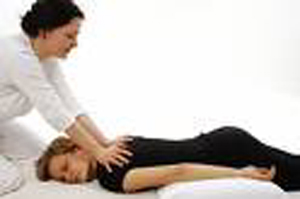
Shiatsu
While a Shiatsu treatment resembles a massage in some ways, it differs in several important aspects. The principal aim of Shiatsu is not to work on localized muscles and joints but on the overall energy system. Although the use of physical pressure and stretches to relieve muscular tension and stiff joints is used, the session usually takes place on a mat or futon placed on the floor, and the client remains fully clothed. Kneading and European-style massage techniques are interspersed with palm and finger pressure at precise points and energy pathways of the body to help promote and balance the flow of the universal force of life (ki), enhancing the body's own healing powers. The treatment stimulates the circulation and the flow of lymphatic fluid, releases toxins and tensions from the muscles, stimulates the hormonal and immune systems, and acts on the autonomic nervous system, allowing the recipient to relax deeply and to get in touch with his/her own healing power. Following a treatment, the client may experience increased vitality as well as feeling invigorated yet relaxed.A practitioner of Shiatsu can enable each client to connect more deeply with the ability to self-heal. Shiatsu is an art that supports and improves the client's own natural ability to achieve a more balanced state. It improves and quiets breathing, stimulates circulation of blood and lymph and enhances well-being. Shiatsu can also enhance vitality, stamina and balanced energy. A Japanese healing art deeply rooted in the philosophy and practices of Traditional Chinese Medicine, Shiatsu can be viewed as complementary to other systems of medicine rather than as an alternative form of medicine. Its focus is on balancing and revitalizing the client's energy system holistically. In Eastern cultures, a doctor's practice is traditionally centered around keeping people healthy as they move through life rather than on giving treatments to people who have fallen ill.
